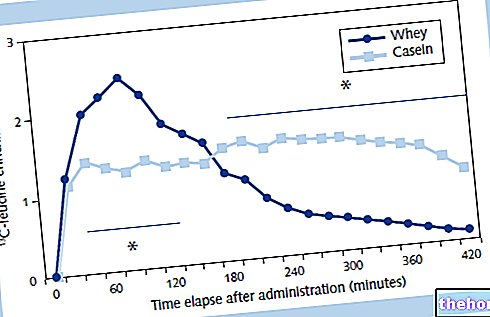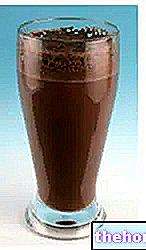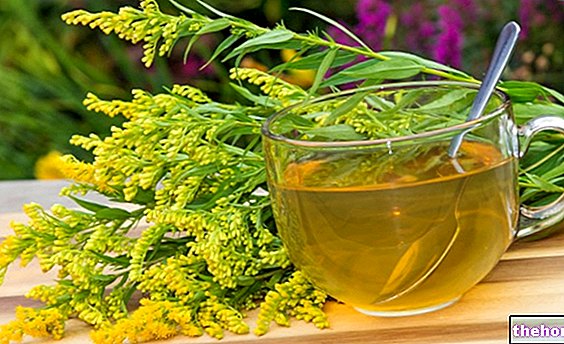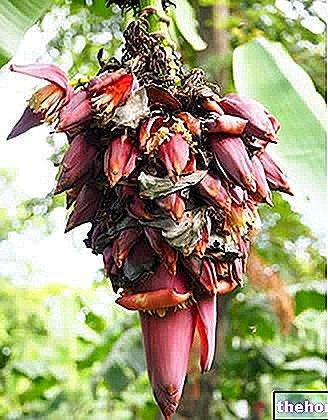Two plants particularly rich in tannins are grouped under the term Potentilla, respectively called:
tormentilla (Pontetilla tormentilla Nec. = P. erecta L. Rau.)
and argentina (Potentilla anserina L.).

Potentilla tormentilla
Botanical name: Pontetilla tormentilla Nec. = P. erecta L. Rau.
Family: Rosaceae
Drug: rhizome
Herbaceous plant widespread in wooded and cool places in central and northern Europe. It has basal leaves divided into three to five lobes, with flowers of a very intense yellow, isolated and composed of four petals (contrary to the characteristic predominant pentamera in the family). Italy can be found in the submontane and alpine areas.
Catechetical tannins (17-22%)
Tormentolo, pigment
Starch
Flavonoids
Saponosides
Astringent, antidiarrheal
Cicatrisants (external use)
Hemostatic, anti-inflammatory
Antibiotics to some micro-
organisms, antivirals
MAIN INDICATIONS: the rhizomes of tormentilla are particularly rich in tannins; therefore, if taken orally, they are a valid natural remedy against diarrhea. In the form of rinses they are indicated in the symptomatic treatment of inflammations of the oral cavity (canker sores, mouth ulcers, etc.).
FURTHER INDICATIONS: tormentilla is indicated not only in the symptomatic treatment of oral inflammations, but also in that of other accessible mucous membranes. The healing and antibacterial properties justify its topical use for the cleansing of sores and wounds, also benefiting from the stimulating action on skin repairing processes.
The astringent properties of tormentilla can make it a useful hemostatic remedy to stop bleeding of various kinds, such as epistaxis and bleeding from hemorrhoids.The anti-inflammatory and haemostatic action makes it particularly suitable for the local treatment of gingivitis and stomatitis, through gargling or brushing with undiluted dye. The tormentilla, and even more the argentina, are indicated - in the form of irrigations - also in the treatment of leucorrhea.
NOTES: tannins cause vasoconstriction, hindering vasodilation and the consequent increase in vascular permeability that accompany inflammatory phenomena. When applied topically to damaged skin or mucosa, they bind tenaciously to epithelial cell proteins. Once in contact with the intestinal mucosa, therefore, the tannins decrease its permeability, producing an astringent effect particularly useful in the presence of diarrhea. At this and other levels, protein coagulation leads to the formation of a protective and antisecretive layer, useful for preventing the passage of pathogenic microorganisms and calming local inflammation.
METHOD "D" USE AND DOSAGE:
Infusion (for internal use): single dose prepared with 1.4 - 4 grams of drug (dried and finely chopped tormentilla rhizome), in 300 ml of water, to be consumed several times a day up to a maximum daily dosage of 12 grams of drug. Take as directed by the herbalist.
Decoction (for internal use): single dose prepared with 1.4 - 3 grams of drug (dried rhizome of tormentilla) in 300 ml of water, to be consumed several times a day up to a maximum daily dosage of 6 grams of drug. the indications of the herbalist.
Decoction (for rinsing, gargling, compresses and external use): 50 grams of drug (dried rhizome of tormentilla) per liter of water.
Powder / dry extract: take 4-6 grams of drug per day divided into three intakes, as recommended by the herbalist or the product label.
Potentilla or Tormentilla - Properties and Uses in Phytotherapy and Homeopathy
Watch the video
- Watch the video on youtube
SIDE EFFECTS, CONTRAINDICATIONS, WARNINGS
Contact your doctor if diarrhea persists after three to four days of treatment with potentilla tormentilla. Given the absence of reliable data on the toxicity profile in such conditions, its use in pregnancy, lactation and under 14 years is not recommended.
The use of herbal preparations, including those based on tormentilla, can negatively interfere with the absorption of other drugs, increasing or decreasing their therapeutic effect. It is therefore advisable to take this remedy at least 2-3 hours after " taking medicines.
In sensitive patients, treatment with potentilla tormentilla may cause episodes of nausea and vomiting.
Select plant Fir Acacia Acerola Sorrel Yarrow Yarrow Yarrow Aconito Adatoda Garlic Agnocasto Agrimonia Alchemilla Alkekengi Aloe Altea Witch Hazel Ammi or Visnaga Pineapple Andrographis Anemone Pulsatilla Angelica Anise Star Anise Japanese Star Anise Bitter Orange Bitter Areca Arnica Harpagophytum Arpagophyte Artemisia Asteragus Basil Asparagus Asparagus Peruvian Asparagus Asparagus Asparagus Hawthorn Boldo Borage Shepherd's Purse Boswellia Bucco Butea superba Cocoa Coffee Cajeput Calamus Calamus Marigold Camedrio Chamomile Roman Chamomile Camphor Cinnamon Ceylon Maidenhair Capuchin Artichoke Cardamom Cardiac Thistle Asian Thistle Carvi Cascara Cassia Catecu Catha Cabbage Celandine Chicory Centaurea Cinnamon Cypress Celandine Chives Cypress Coca Cola Colchico Combreto Condurango Comfrey Coriander Cranberry Barberry American Chrysanthemum Cumin Turmeric Damiana Digital Dioscorea Drosera Dulcamara Dunalilella Echinacea Eder a Ephedra Elenio Eleutherococcus Helichrysum Evening primrose Horsetail Alfalfa Erica Euphrasia Erisimo Escolzia Eucalyptus Farfara Farfaraccio Calabar bean Fenugreek Fennel Phytolacca Frangola Ash Fumaria Japanese Mushrooms Galega Ganoderma lucidum Garcinia Cambogia Mulberry Gentian Broom Ginkgo Ginkgo Guipana Guipana Gynestra Ginkgo Hibelia Gymnasium Hibiscus Guarulp St. John's Wort Horse Chestnut Ispaghul Hyssop Jaborandi Kava kava Konjac Laminaria Cherry Laurel Lavender Lemongrass Lespedeza Lovage Icelandic Lichen Lemon Flax Lippia Licorice Lobelia Hops Maca Marjoram Maize Mallow Manna Marrubio Marrubio d "water Matè Melaleuca Meliloto American Lemon balm Myrtle Myrama Walnut Nutmeg Walnut vomica Olive tree Meadowsweet Ononide Opuntia Oregano Orthosiphon Nettle Poppy Papaya Parietaria Feverfew Passiflora Chilli Perilla Periwinkle Phyllanthus Plantain Picrorhiza Pilosella Pino Pisci dia Podofillo Polygala Grapefruit Parsley Psyllium Pueraria mirifica Butcher's broom Pygeum Quassia Oak Rhubarb Ratania Rauwolfia currant Castor bean Rhodiola Rosehip Rosemary Rue Willow Sarsaparilla Sage Elderberry Sassafras Sedum Ergot Senna Serenoa Repens Soybean Solidago Tansy Taraxus Tamarind Tamarind Tamarind Tamarind Tamarindo Ursina Valerian Vanilla Mullein Verbena Veronica Viburnum Vinca Pansy Mistletoe Vine Withania Yohimbe Saffron Ginger Pumpkin Select disease Juvenile Acne Rosacea Tinnitus Tinnitus Aerophagia Tendon Affections Afonia Aphthae Algias Functional Halitosis Breastfeeding Allergy Anemia Anguish Anxiety Arteriosclerosis Asthrosis Asthrosis Arthritis Arthritis Men Sex Woman Blepharitis and Conjunctivitis Eye bags Bronchitis Gallstones Kidney stones Salivary stones Baldness Androgenetic Candida Fragile hair Caries Headache Cellulitis Motion sickness Cystitis C limaterio Cholecystopathy High cholesterol Ulcerative colitis Colonoscopy Contusions Hematoma Convalescence Couperose Depression Dermatitis Diaper dermatitis Diabetes Diarrhea Erectile dysfunction Dyslipidemia Dysmenorrhea Dyspepsia Disturbances of vision Hemorrhoids Epistaxis Herethism Heart disease Fever Fibromyalgia Gastro-intestinal disease Flatulence Hypertension Fibromyalgia Gastrointomnia Jaundice Laryngitis Renal lithiasis Toothache Sore throat Thinness Menopause Meteorism Mononucleosis Alzheimer's disease Crohn's disease Nausea Vomiting Obesity Dark circles Onychomycosis Osteoporosis Dry skin Periarthritis Piorea Low pressure Prostatitis Psoriasis Colds Breast fissures Anal fissures Gastro-nasal rhinitis Senescence Premenstrual Syndrome Sinusitis Quit smoking Overweight Fatty liver Constipation Stomatitis Stress Cough Triglycerides high Ulcer Burns Nails Brittle flashes Heat Warts Dizziness Properties herbal Tanning Abortive adaptogenic Aphrodisiac bittering analgesic anesthetic anorectics analgesic antacid anti-allergic anti-asthmatic Antibiotic catarrh Anticellulitiche anticonvulsant Antidiaforetiche antidiarrheal edematous anthelmintic antiemetic Antiemorroidarie antiphlogistic Antiidrotiche Antinevrotiche Antioxidants antipyretic antirheumatic antiscorbutic Antiseptic antispasmodic anti-uric Aperitive Flavoring Astringent Balsamic Bechiche Capillarotrope Cardiotonic Carminative Cathartic Caustics Healing Cholagogues Choleretic Dyes Decongestants Deodorants Purifying Diaphoretic Cleansers Disinfectants Detoxifiers Thirst quenching Diuretics Exciting Emetics Emmenagogues Emollients Hemostatic Energies Hepatoprotectors Expectorants Eupepticus Moisturisers Galactosensitizers lanti Hypertensive Hypnotic Hypoglycemic Hypotensive Irritants Laxatives Soothing Narcotic Nerves Nutrients Odontalgic Pectoral Purgative Revulsive Remineralizing Refreshing Rubefacient Scialagoghe Sedative Soporifugas Sneezing Stomachic Stomatics Narcotic Vascular Tightenitis




























